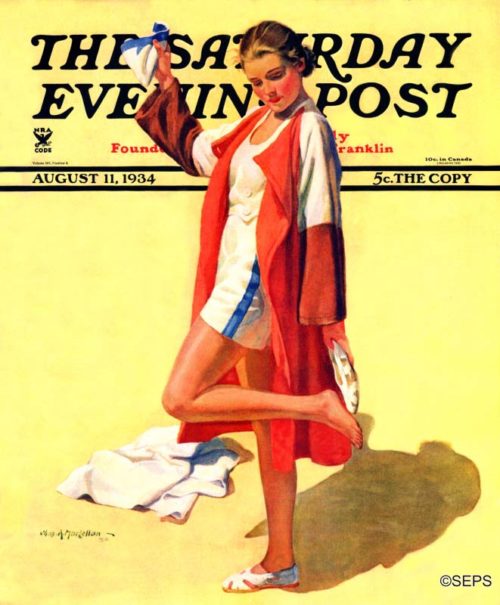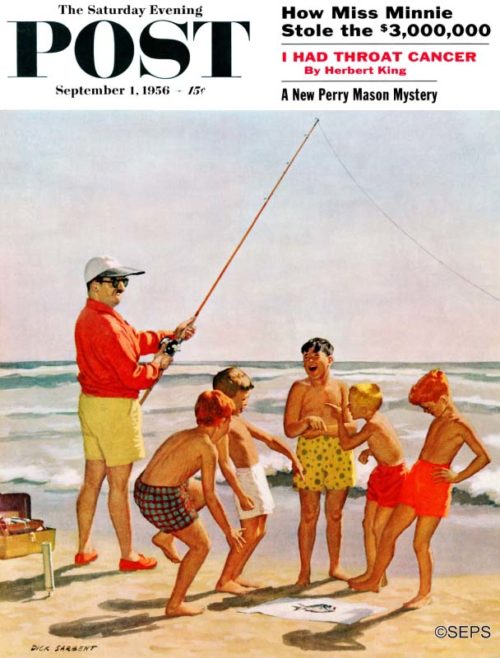Cover Gallery: A Day at the Beach
These beachgoers on the covers of the Post are having the dream summer vacation.

Ellen Pyle
August 7, 1926
The Saturday Evening Post was the first magazine to accept Ellen Pyle’s work after her husband’s death in 1919. “The girl I am most interested in painting is the unaffected natural American type,” Pyle said in her 1928 interview with the Post. Her children often posed as models for Pyle’s paintings, but it was her brilliant use of color and loose, broad brushstroke style that made her one of the Post’s most recognizable female artists.

Charles A. MacLellan
August 11, 1934
Charles A. MacLellan started creating art for the Post during a time when narrative illustrations dominated the covers. His most memorable covers were those with children, typically boys. Often these boys were in some kind of trouble, but it’s the kind of trouble that makes their viewer smile. In his portraits of women, MacLellan nearly always drew them in action and often gave his models a prop, such as this woman and her beach clothes.

Alex Ross
August 28, 1943
This is one of six covers that Alex Ross painted for the Saturday Evening Post. All of his covers featured beautiful women, but this beach scene is the only one that doesn’t focus on a single girl. This 1943 cover does follow Ross’ usual style, however, because the women don’t appear to be over-joyed about their card game.

Constantin Alajalov
July 27, 1946
Constanin Alajalov’s painting of the new arrivals picking their green and embarrassed way through the tanned regulars, could have been made on any beach in the country. For that feeling of outstanding pallor is well known from coast to coast, and there is no lotion for it, except that in a few days you can sneer at even later arrivals. Alajalov made his sketches in Palm Beach, Florida, when the Northerners were arriving last winter.

John Falter
August 14, 1948
Artist John Falter’s setting for his surf-bathing cover is Ogunquit, Maine. He made his first sketches while spending the summer in Maine, but didn’t get around to painting until last winter. By that time the lucky lad was in Phoenix, Arizona. The hotter that Arizona sun got, the more fondly the artist thought of Maine’s cool air and cool spray. So he went to work on a picture of Maine as remembered in the Southwest. The pretty girl in the left foreground, just emerging and shaking out her hair, often appears in Falter’s cover paintings. But doesn’t get a model’s pay for her work. She is Margaret Falter. John’s wife.

Austin Briggs
July 23, 1949
Don’t worry about the tiny cover girl who is going down to the awesome sea with her eight-inch ship. Just as Austin Briggs, who was vacationing at Folly Beach, Charleston, South Carolina, spied the seagoing tot, her mother let out a yelp and splashed into the foam after her. Now there, thought Briggs prophetically, could be my first Post cover.

George Hughes
August 2, 1952
In the winter, people buy sun lamps to get sun, and in the summer they buy beach umbrellas to keep the sun off. Well, have a wonderful time, folks; build your sand castles and your dream castles; let the cool winds and the hot dogs renew you; and don’t even let the annoyment creep in if that boy’s radio prevents your hearing the sweet nothings he whispers to his girl. Now turn the page, before the kids start throwing sand.

Richard Sargent
September 1, 1956
Mr. Rodney Fischer, an eminent metropolitan banker who is accustomed to being treated with deep respect, is not being. If that is a sardine he has caught, it may cop the surf-casting championship, for it is indeed of great size. But the boys’ happy faces and the man’s apoplectic face indicate that it is a small sample, or child, of something more ambitious. Mr. F. should set his rod in the gadget Dick Sargent has painted behind him, and lie down and relax his bile; if he goes to sleep, he may catch something decent. While he stands up, his blinding raiment must terrify all the fish who are old enough to think.